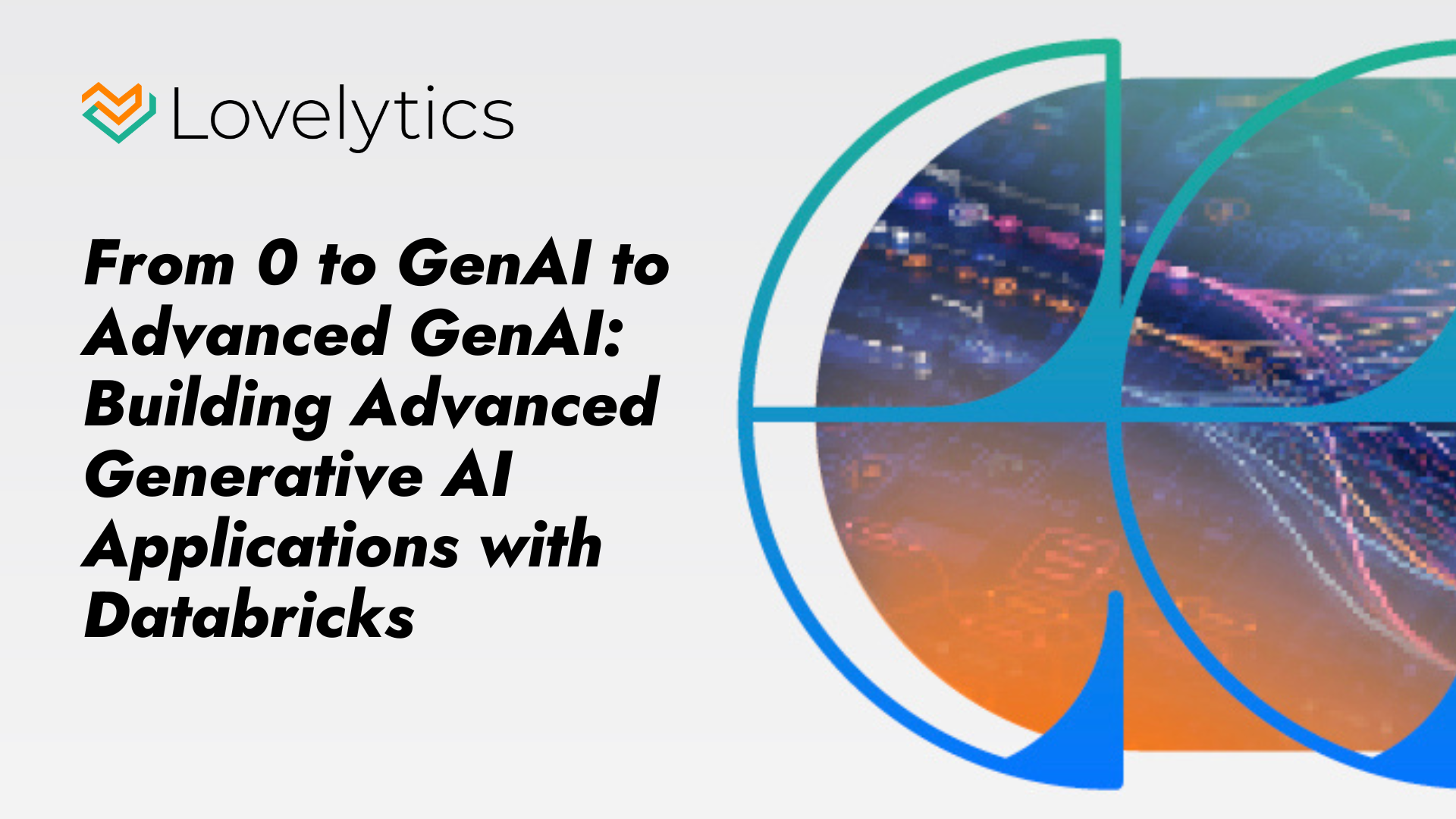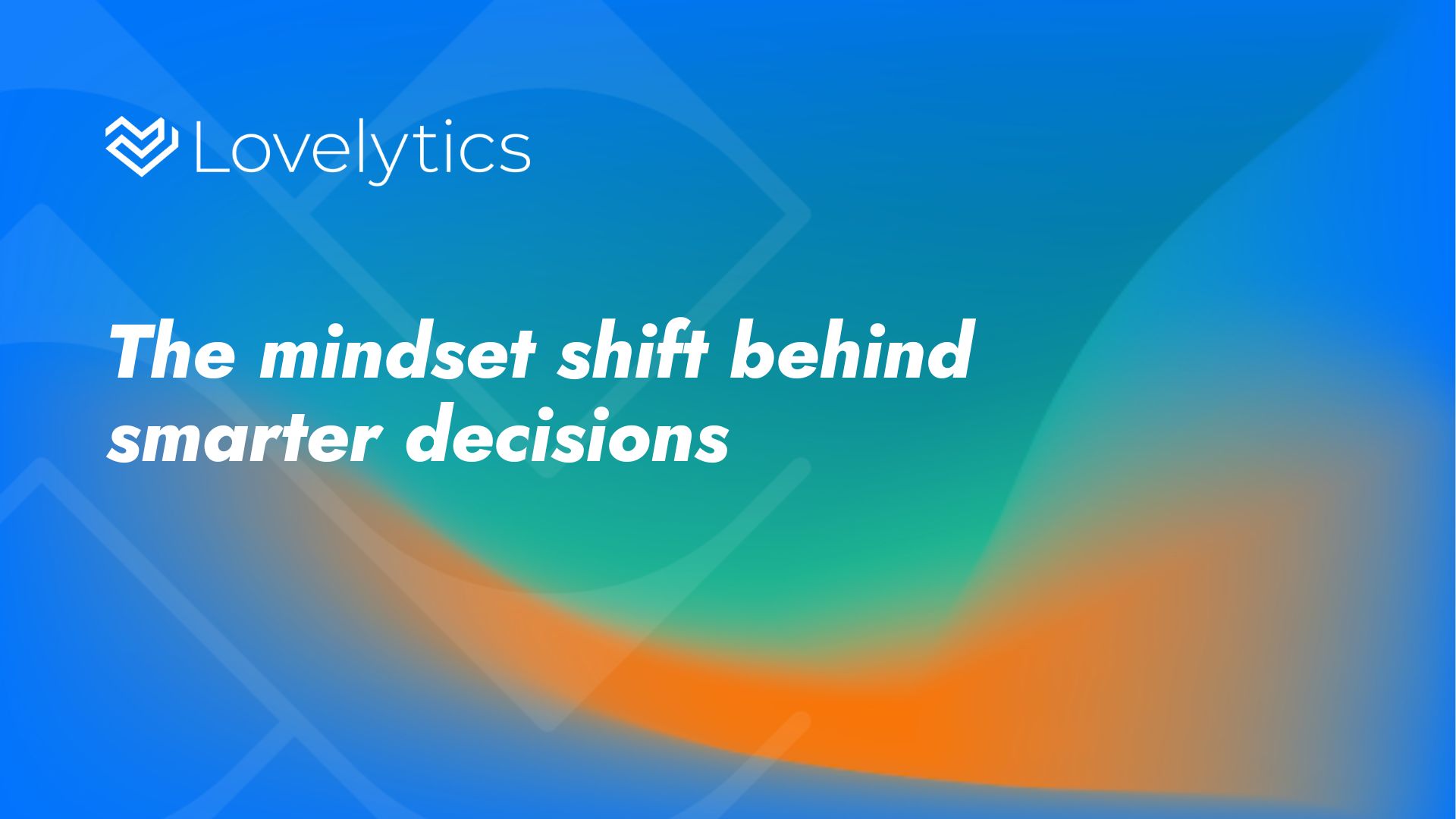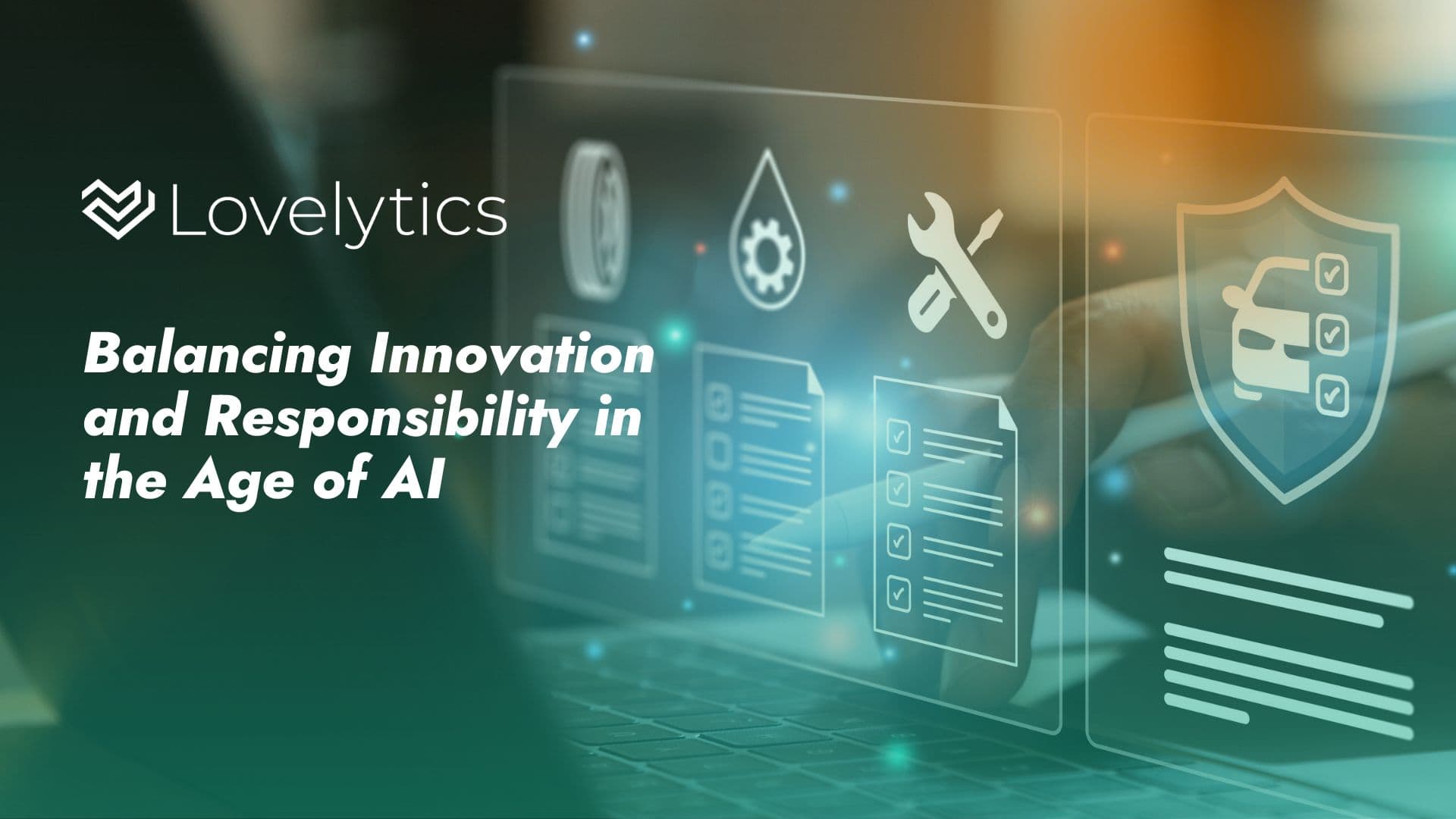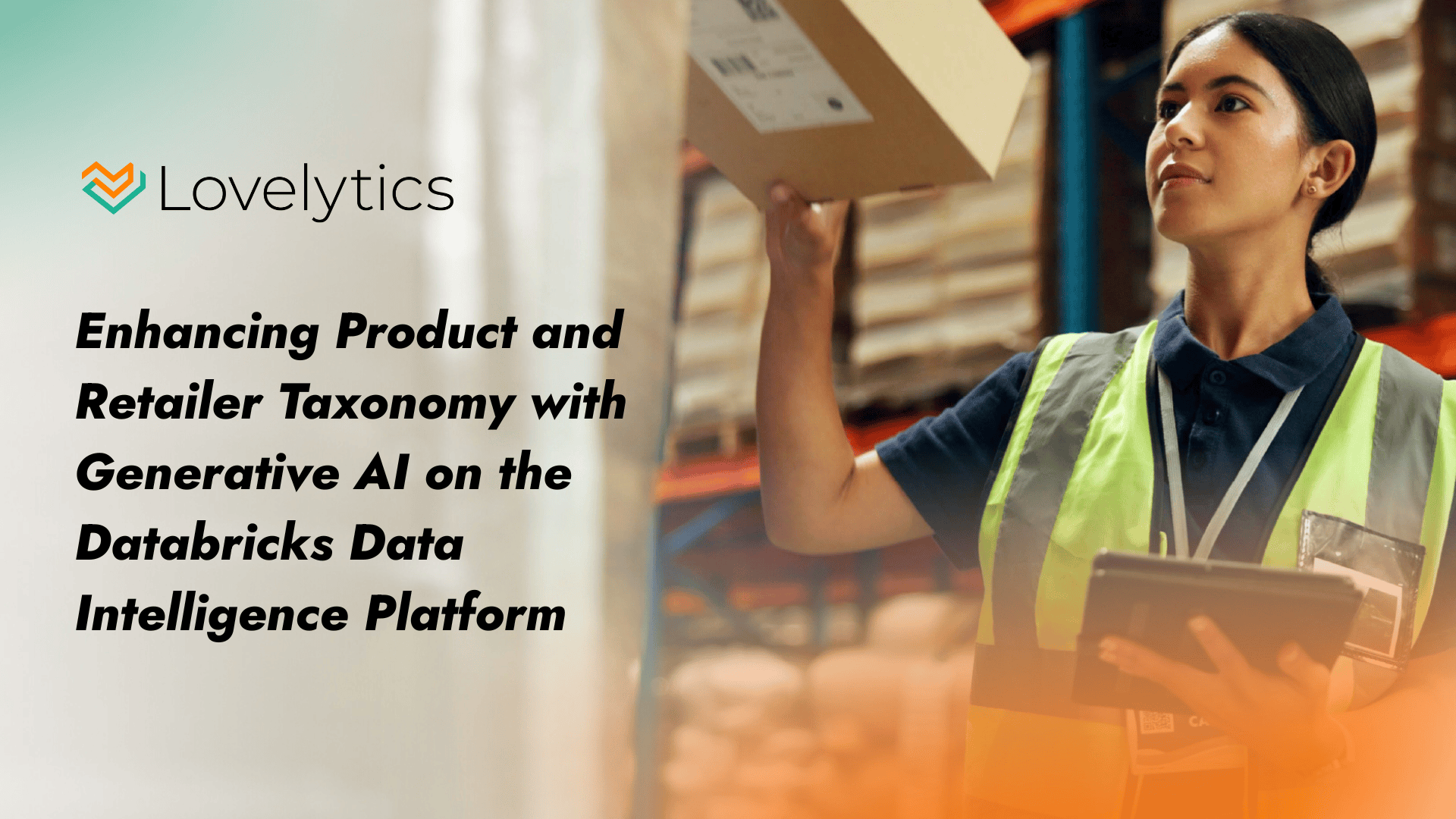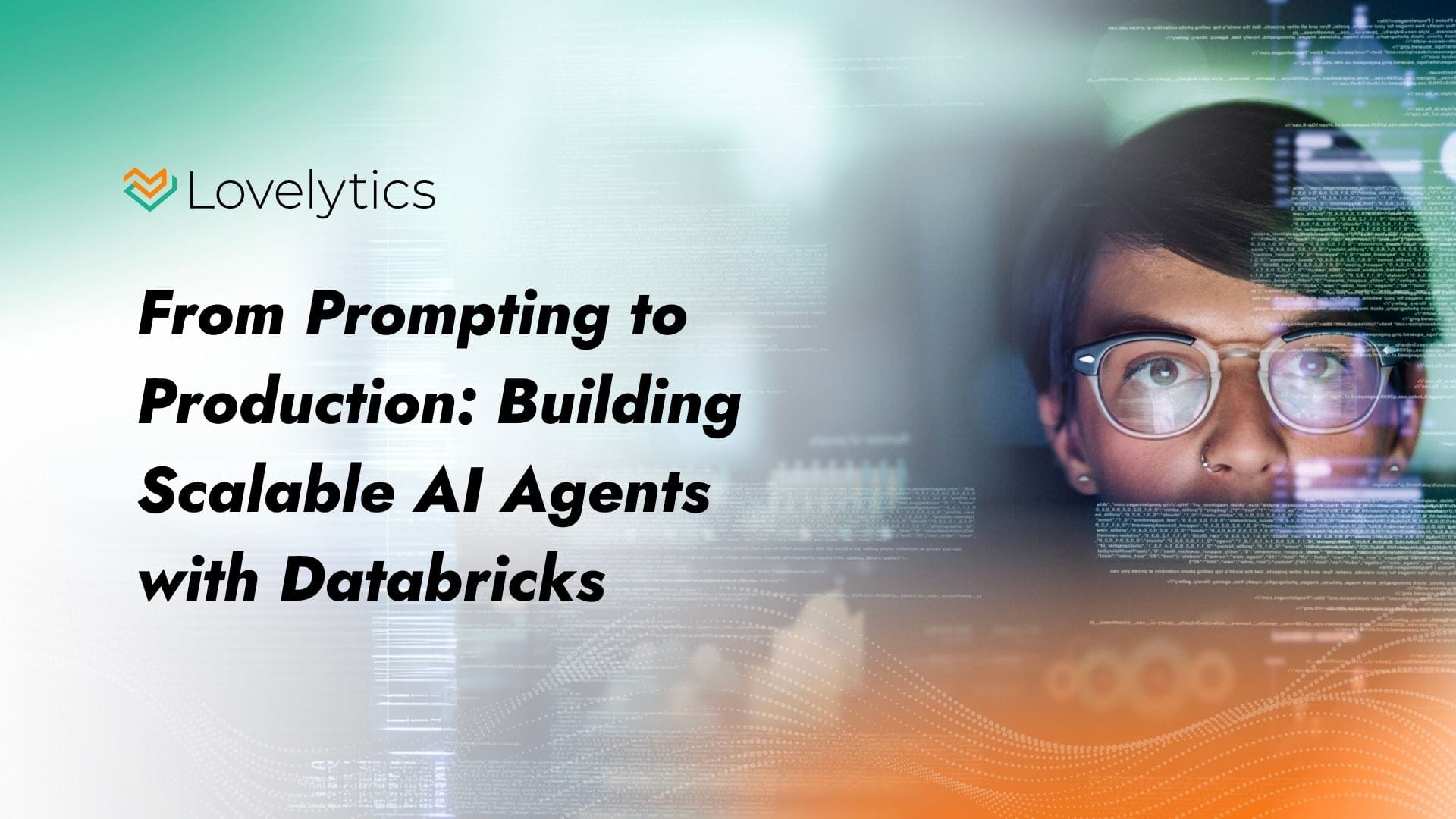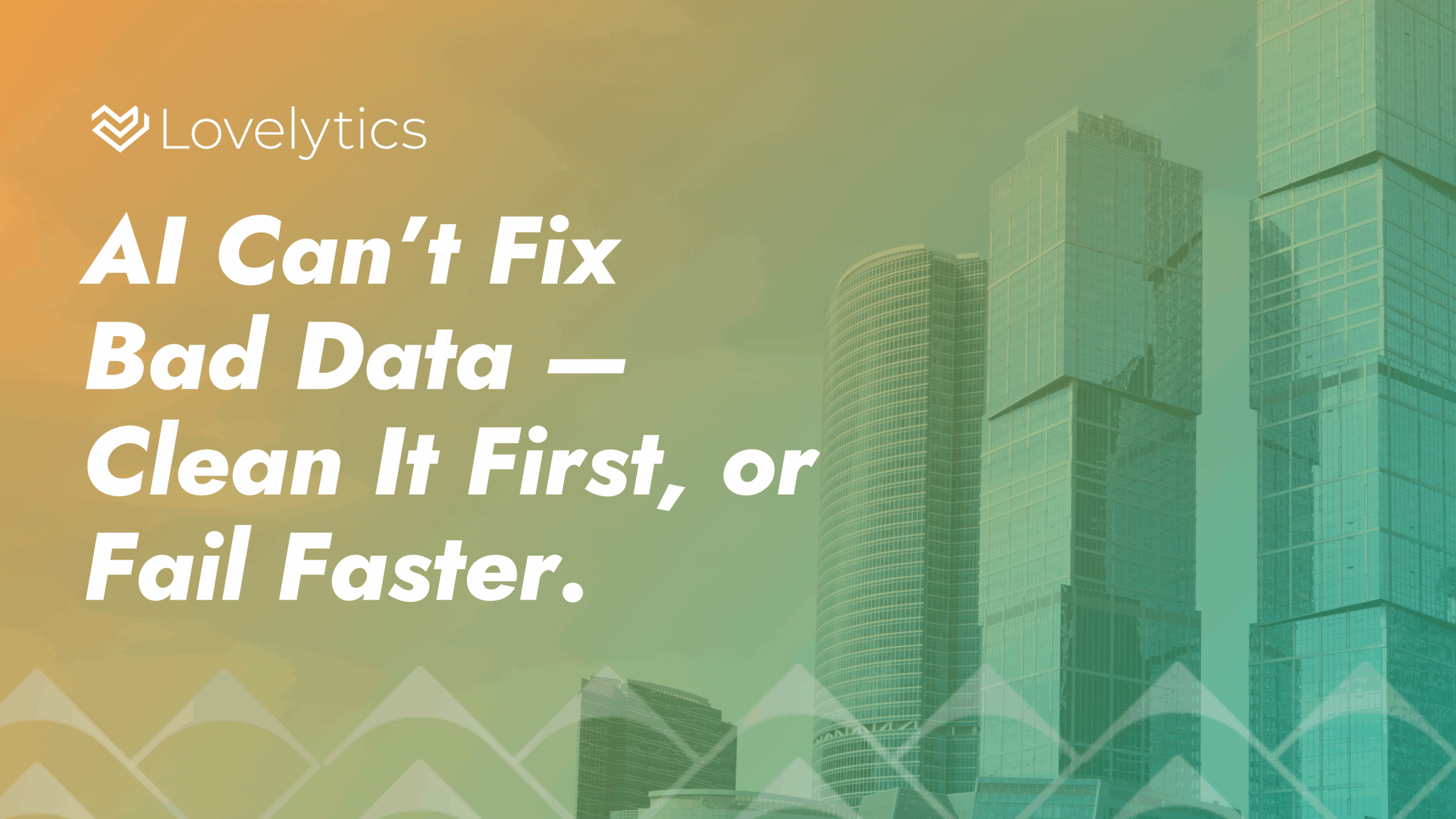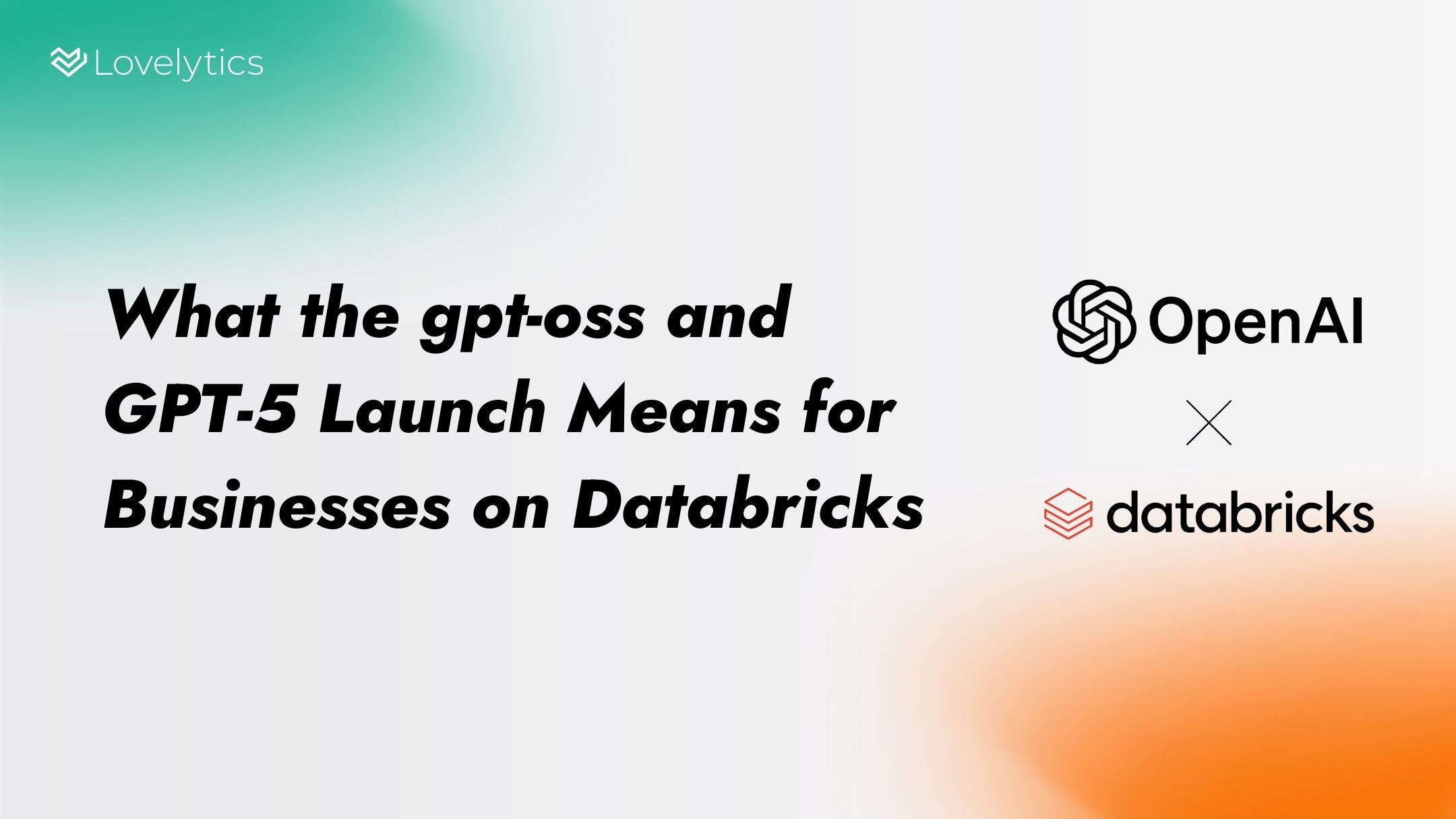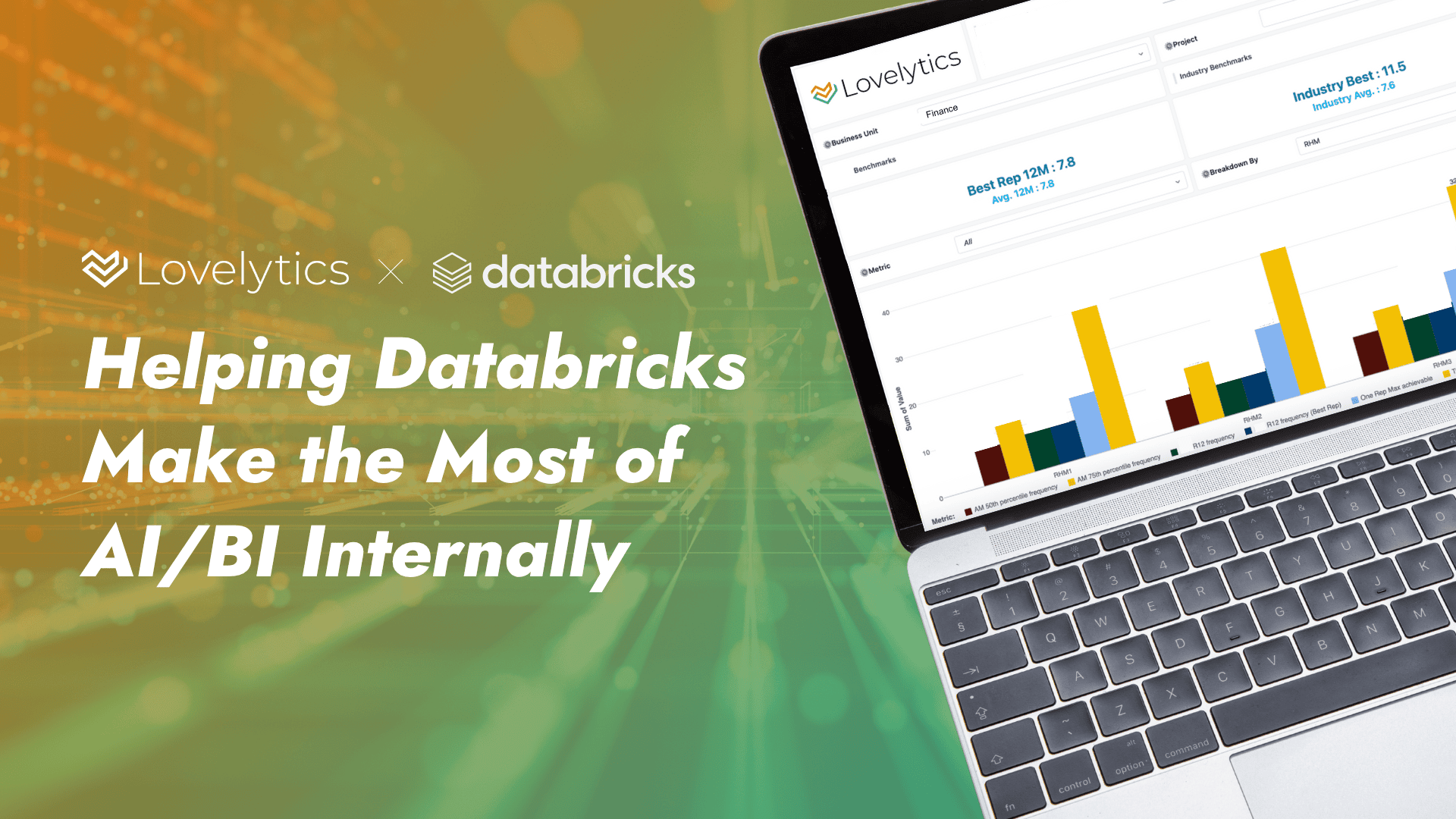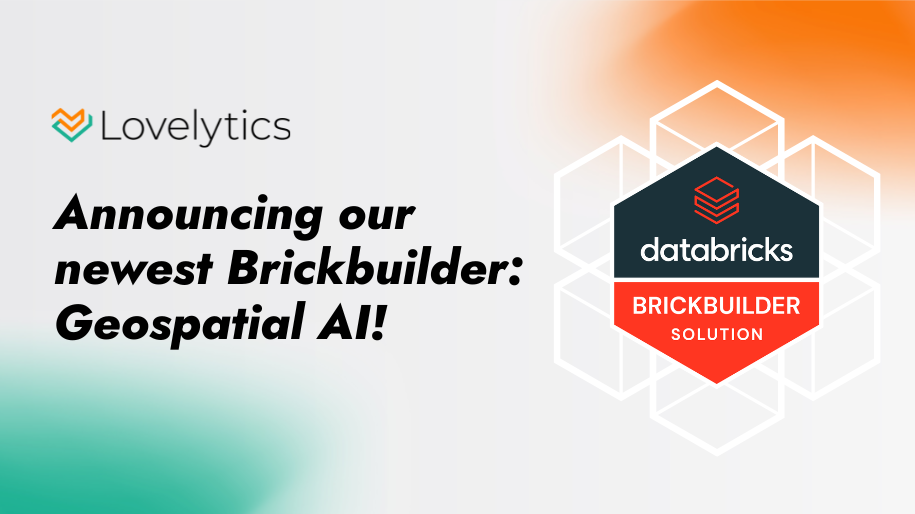Introduction
Lovelytics and Databricks recently hosted a hands-on lab titled “0 to GenAI,“ where participants built a Retrieval-Augmented Generation (RAG) application using the Databricks Data Intelligence Platform. The session walked through a foundational RAG workflow—chunking unstructured documents, generating embeddings, storing them in a vector database, and using LLMs with prompt templates to produce contextual responses.
However, while the RAG approach serves as a crucial foundation, real-world business scenarios frequently demand capabilities beyond basic retrieval and generation. Typical enterprise workflows require advanced generative AI techniques involving contextual reasoning, decision-making, dynamic planning, and execution. Today’s GenAI capabilities on the Databricks Data Intelligence Platform extend well beyond traditional RAG, enabling more sophisticated AI applications that drive substantial and tangible business value. As clients consider scaling their AI initiatives, it becomes essential to understand and adopt these higher-order GenAI approaches to fully unlock transformative insights and efficiencies.
This blog explores how organizations can evolve from foundational RAG to advanced GenAI solutions—leveraging Databricks’ full platform capabilities.
RAG as a Fundamental Building Block
Retrieval-Augmented Generation (RAG) has emerged as one of the most widely adopted patterns in the GenAI landscape. Its strength lies in its simplicity and effectiveness—bridging the gap between static language models and dynamic, enterprise-specific knowledge. By combining a retriever that surfaces relevant content from unstructured data with a large language model that generates human-like responses, RAG transforms general intelligence into domain-specific data intelligence.
On the Databricks platform, this pattern is efficiently implemented through native capabilities such as Vector Search, the Mosaic AI Gateway, integration with foundation and external models, MLflow model management, endpoint deployment, and scalable compute infrastructure. Most common RAG applications include chatbots that answer user questions in a human-like manner by referencing organizational source documents.
While powerful, basic RAG implementations are just the beginning. As organizations mature in their GenAI journey, many business use cases require deeper contextual understanding, the ability to reason across multiple inputs, and the capacity for autonomous task execution. This evolution leads to higher-order GenAI solutions—such as AI Agents—that integrate memory, retrieval, planning, and tool usage.
Databricks provides a robust and extensible foundation to support this transition. Through Mosaic AI and support for open-source frameworks, Databricks enables development teams to move beyond static prompt-response interactions and toward intelligent, dynamic systems that better reflect the complexities of real-world business workflows and decision-making processes.
The GenAI Application Pyramid
As organizations progress beyond foundational RAG patterns, a layered structure begins to emerge—what we at Lovelytics refer to as the GenAI Application Pyramid, as illustrated in the diagram below.
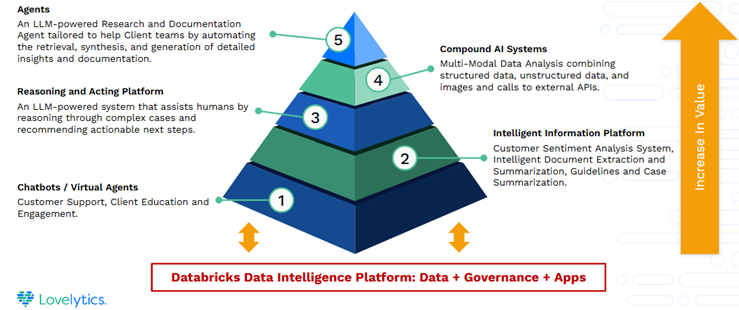
The pyramid shows increasing business value, as you build more capable applications using the Databricks Data Intelligence platform. At the base are simple retrieval-augmented applications, such as chatbots, which answer user queries by combining document retrieval with large language model (LLM) generation. These are essential, but they represent only the first level of potential. These applications are considered ‘LLM centric’ or monolithic with the LLM as the main engine driving cognitive capabilities of the application.
Moving up the pyramid, applications begin to incorporate reasoning, planning, and tool use, combined with enterprise data—hallmarks of more advanced GenAI systems. These include workflows that can synthesize information from multiple sources (internal and external), carry out multi-turn conversations, adapt to user goals, or take automated actions based on contextual data. This level of capability requires the orchestration of memory, task decomposition, dynamic tool calling, and agentic behaviors.
At the top of the pyramid are Compound Systems and AI Agents—intelligent entities capable of chaining together multiple tools, making decisions across steps, learning from feedback, and operating semi-autonomously. These systems go far beyond Q&A and represent the frontier of what businesses can achieve with GenAI.
As GenAI design paradigms evolve, the conceptual and implementation boundaries between Compound AI architectures and AI Agents are increasingly blurring. They are not mutually exclusive; in fact, for most AI Agents, a Compound AI architecture typically serves as the foundational framework—integrating retrieval, reasoning, planning, and tool use into a cohesive, intelligent system.
Compound AI systems
In the now widely referenced blog post titled “The Shift from Models to Compound AI Systems”—authored by Matei Zaharia, Jonathan Frankle, Naveen Rao, Ali Ghodsi, and researchers from Databricks and the Berkeley Artificial Intelligence Research (BAIR) Lab—Compound AI Systems are defined as AI systems that tackle tasks through multiple interacting components, including repeated calls to models, information retrievers, and external tools. This contrasts with traditional AI models, such as Transformers, which operate as statistical models that predict the next token in a sequence without coordination across systems. The authors argue that Compound AI systems are poised to deliver more powerful and generalizable AI outcomes, representing one of the most impactful shifts in the evolution of AI.
At Lovelytics, we recently implemented a Compound AI system to solve a complex challenge in Product and Retailer Taxonomy Generation. Traditionally, creating highly accurate taxonomies for tens of thousands of products and retailers—especially using manual or non-GenAI software techniques—would take months of effort. Even then, the resulting taxonomy would often fall short of the precision required for critical business applications such as personalization, recommendation engines, or merchandising optimization.
Our Compound AI approach integrates multiple components across modalities and services to dramatically reduce time-to-insight and improve accuracy:
- Multi modal and text LLMs: LLMs—both multimodal and text-based—were used for image recognition, feature extraction, classification, and predicting taxonomy categories. Databricks supports this seamlessly through its Mosaic AI Model Serving platform, which enables easy access to both foundation and external models.
- Azure Maps API: Utilized for nearby business and place discovery via the Nearby Search feature.
- Google Street View API: Retrieves street-level imagery to enrich product or store context.
- PySpark: Powers document chunking and large-scale data preparation workflows.
- MLflow: Handles model deployment, experiment tracking, and lifecycle management.
- Unity Catalog Model Registry: Provides governance, access control, and model versioning at scale. The API keys and credentials are securely stored and managed using Unity Catalog’s secrets integration, ensuring controlled access and governance across the pipeline.
This implementation showcases how Compound AI systems, built on the Databricks platform, can orchestrate structured data, unstructured documents, external APIs, and multimodal inference pipelines—delivering results at speed and scale that were previously impractical using conventional methods.
Another example of a Compound AI system is Real Estate Analytics, as shown in the diagram below. In this use case, structured and unstructured data sources—such as county records, tax data, and street-level imagery—are processed using both text-based and multimodal LLMs. These models extract features and generate insights, which are then passed to a reasoning LLM that synthesizes the information to produce analytics outputs. The result: actionable metrics such as desirability scores, affordability indicators, and other key real estate insights that support informed decision-making.
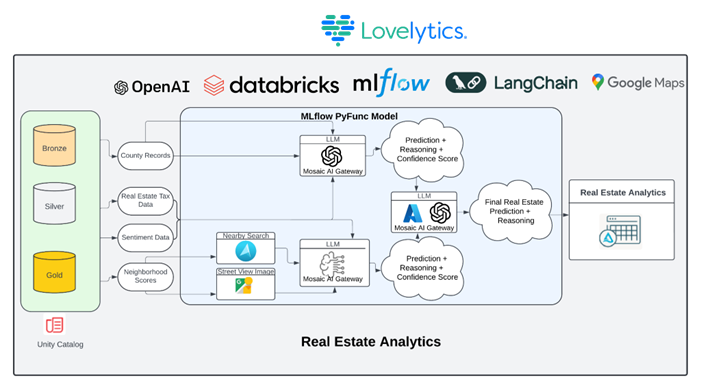
AI Agents
AI agents are intelligent systems that reason, plan, and act autonomously to complete complex, multi-step tasks. Unlike traditional models that generate single responses, agents coordinate tools, APIs, and language models to achieve defined goals. This makes them ideal for real-world applications like customer support, analytics assistants, and process automation—where adaptability and decision-making are essential for driving efficiency and business value.
Databricks offers a powerful platform for building and scaling AI agents with enterprise-grade reliability. Tools like the Mosaic AI Agent Framework enable rapid development and evaluation, while Unity Catalog ensures secure governance of data and tools. Mosaic AI Gateway provides centralized governance for both open source and commercial AL models. Provision-less batch inference to run batch inference with Mosaic AI using a single SQL query, eliminating the need to provision infrastructure while enabling seamless unstructured data integration, while Model Serving supports scalable deployment—making Databricks an end-to-end solution for operationalizing intelligent, secure AI agents.
At Lovelytics, we prototyped a Dynamic Supply Chain AI Agent on the Databricks Mosaic AI platform. This AI Agent uses a multi-LLM system to automate and optimize supply chain requests. The Planner Model breaks down a natural language request into a structured step-by-step plan. The Executor Model then carries out each step by invoking specific tools to retrieve or update real-time data.
The agent reasons through constraints like inventory, location, and weather, and intelligently allocates supply across three plants to fulfill the request at the lowest cost and via the most optimal route—automating what would traditionally take hours into minutes. The process flow diagram below illustrates how we build this agent on the Mosaic AI Agent platform.

Art and Science of Production-Grade GenAI Applications
As organizations move beyond experimentation, deploying and piloting production-grade Generative AI applications becomes a strategic priority. These applications are no longer confined to innovation labs—they are being integrated into critical business processes, decision-making workflows, and customer-facing systems. The business value is clear: production GenAI can automate complex tasks, accelerate time-to-insight, and enhance user engagement at scale. But with this value comes the need for rigor, reliability, and governance.
Accuracy and reliability are non-negotiable in production environments. Unlike early-stage prototypes, production GenAI systems must deliver consistent, trustworthy outputs that align with business goals and user expectations. Errors or hallucinations can lead to poor decisions, reputational risk, or compliance issues. This is where the science comes in—measuring, evaluating, and optimizing model performance with precision.
The Databricks Mosaic AI Agent Framework addresses this challenge head-on. It provides built-in tools for developing, evaluating, and refining GenAI agents and applications. Teams can implement custom evaluation logic, define quality metrics, and continuously test outputs using both automated and human-in-the-loop methods. With integrated feedback loops, developers can iterate rapidly while ensuring quality and alignment with organizational standards.
A critical component of this process is the involvement of business Subject Matter Experts (SMEs), the art of the evaluations. Through tools like the Mosaic Agent Evaluation Review App, SMEs can directly review model outputs, provide contextual feedback, and guide refinement cycles without needing to write code. This collaboration between domain experts and technical teams ensures that GenAI applications meet the nuanced requirements of the business—bridging the gap between technical performance and practical value.
The recently published Databricks blog ‘Unlocking the Potential of AI Agents: From Pilots to Production Success’, highlights the process of scaling AI agents beyond POCs as illustrated in the diagram below. We encourage the reader to review the blog and other AI Agents blogs recently published by Databricks.
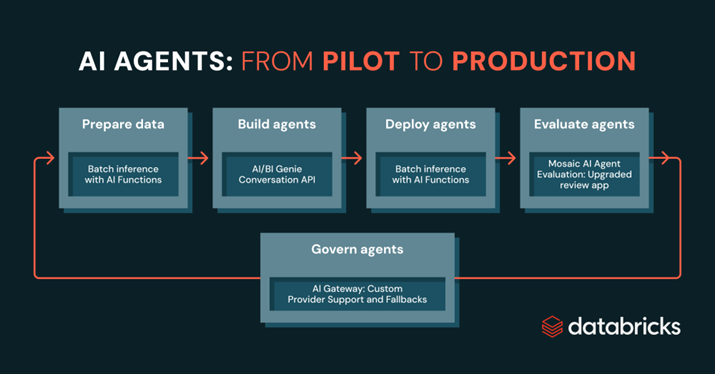
Advanced Optimization Techniques: Test-Time Adaptive Optimization
Databricks continues to lead innovation in GenAI with groundbreaking techniques designed to close the gap between experimentation and production. One such advancement is Test-Time Adaptive Optimization (TAO)—a novel, enterprise-grade methodology that significantly improves large language model (LLM) performance without requiring labeled training data. TAO is a game-changer for organizations looking to scale their GenAI workloads efficiently and cost-effectively.
At its core, TAO leverages a combination of test-time computation and reinforcement learning to fine-tune LLM responses dynamically. Instead of depending on expensive and time-consuming human-annotated data, TAO uses an internal reward mechanism to evaluate and iteratively improve model outputs. The process includes generating multiple candidate responses, scoring them with task-specific rules or LLM-based judges, and then updating model weights based on reinforcement learning. This enables the model to converge on high-quality, task-aligned outputs—rapidly and at scale.
The TAO workflow consists of four main stages:
- Response Generation: Candidate outputs are created from real prompts (often collected via the Databricks AI Gateway), using structured and exploratory prompting techniques.
- Response Scoring: Each response is assessed using custom validation logic, preference-based ranking, or reward models.
- Reinforcement Learning: The model is updated to favor high-quality responses based on the scoring phase.
- Continuous Improvement: Ongoing user interactions feed into future iterations, forming a self-improving “data flywheel.”
TAO offers several key advantages:
- No labeled data required: Reduces reliance on human annotation, streamlining the tuning process.
- Outperforms supervised fine-tuning: Delivers better results, even compared to large, labeled datasets.
- Efficient and scalable: Improvement scales with compute, not manual effort.
- Low inference cost: Optimization overhead occurs only during training.
- Maximizes existing data: Uses real enterprise usage data already being generated.
- Faster deployment: Removes data bottlenecks, accelerating iteration cycles.
- Empowers smaller models: Boosts the performance of open-source models like Llama, making them viable for enterprise workloads.
- Supports continuous refinement: Built-in feedback loop enables ongoing model enhancement with real-world data.
With TAO, Databricks enables enterprises to achieve production-grade LLM performance without the friction of traditional supervised learning—paving the way for faster innovation, better user experiences, and more scalable GenAI solutions.
Databricks Apps: From AI Innovation to Real Business Impact
At Lovelytics, we love using Databricks Apps—and we’re proud to be early adopters and active evangelists of this powerful capability. In the world of GenAI and machine learning, innovations matter only when they reach the business users who need them. Databricks Apps help bridge that gap by making it simple to turn AI prototypes into secure, interactive applications—fast.
Here’s why Databricks Apps are transforming the way teams deliver value:
- Unified Governance and Security: Every app is governed by Unity Catalog, ensuring that data access is controlled, lineage is tracked, and security is enforced by default. This keeps all data and logic within your trusted Databricks environment, maintaining compliance with internal policies and external regulations.
- Rapid Prototyping and Deployment: With native support for familiar Python frameworks like Streamlit and Dash, data scientists can transform models into usable apps in minutes. Built-in serverless deployment eliminates the need for infrastructure setup, making app launch quick and frictionless.
- Collaboration and Accessibility: Apps can be shared instantly with business stakeholders via a simple URL—no technical expertise required. This enables direct interaction with GenAI models, dashboards, and insights, fostering true collaboration between technical and business teams.
- Performance at Scale: Running on the Databricks engine, these apps are optimized for big data and advanced AI workloads, enabling faster experimentation and more responsive performance—even with complex models or large datasets.
- Focus on Value, Not Infrastructure: Databricks Apps are fully managed and deeply integrated with your existing data and AI stack. Teams can focus on building and iterating impactful AI solutions without worrying about provisioning, scaling, or compliance overhead.
In short, Databricks Apps streamline the journey from AI model to business value. They empower data teams to deliver intelligent solutions that are secure, scalable, and—most importantly—usable by the people who need them most.
Conclusion
Lovelytics and Databricks are empowering organizations to move beyond basic RAG patterns and embrace the full potential of enterprise-ready GenAI. Together, we’re helping teams progress from foundational use cases—like document-based Q&A—to sophisticated applications that involve reasoning, planning, tool use, and real-time interaction across diverse data modalities.
With Databricks’ powerful Data Intelligence Platform, organizations gain access to cutting-edge capabilities like the Mosaic AI Agent Framework, Test-Time Adaptive Optimization (TAO), and Databricks Apps, all supported by Unity Catalog for robust governance and security.
By bridging the gap between innovation and execution, Lovelytics enables businesses to confidently deploy GenAI solutions on the Databricks platform that are scalable, governed, and designed for real-world impact.
References and Attribution
The Shift from Models to Compound AI Systems
From Generalists to Specialists: The Evolution of AI Systems toward Compound AI
AI Agents Unlocking the Potential of AI Agents: From Pilots to Production Success

